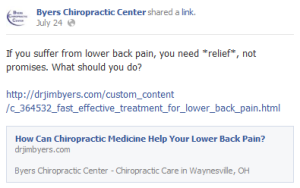If you don’t yet have a mailing list full of subscribers to your blog or content marketing campaign, you will want to read this article.
Your content marketing can really use some assistance from social media. Let’s see how social media and content marketing can be used in an integrated way to market your ideas and your business. Let’s look beyond the ideology of social media that dictates that you must use SM simply because it exists.
Advertising, Publicity, and Content Marketing
Your content needs to be actively marketed. Unless you already have an audience of thousands or millions waiting to read your brilliant prose, you have no built-in audience. That means you need to figure out an economical way to introduce potential readers to your blog or article.
How does content marketing get seen by a meaningful base of readers – be it a few dozen readers, a few hundred, or even millions of people?
Consider The Furrow magazine, launched in 1895 by John Deere farm equipment and read by farmers worldwide. This is one of the earliest examples of content marketing and is published today to a readership of 1.5 million in 12 languages.
How did John Deere’s The Furrow magazine get new subscribers, pre-internet?
The Furrow was promoted by local sales offices for John Deere equipment who signed farmers up for Furrow subscriptions.
So do you have sales representatives who can coax prospects to read your blog?
Or are you willing to spend thousands of dollars on a print or AdWords advertising campaign for your blog to promote your posts?
I didn’t think so. The point I’m making is this: content marketing itself needs to be marketed actively. And what works for well established household names won’t work for you.
Without marketing and publicity, your content is just dead words that don’t get read.

Ferengi Bobble-Head… he’s cute (??!) and he attracts attention, but he has nothing to say. Just like most social media postings.
How Social Media can Benefit Your Content Marketing
How can social media support your content marketing efforts?
First, some clarity on buzzwords. Social media is not, repeat, NOT content marketing and does not take its place.
Social media is about connections, relationships, and spreading connections between people, their ideas, and their audiences. It’s writing, but it’s in small fragments and is energized by internet technology.
Most social media resembles a “bobble head” doll. It bobs up and down, in a way. It attracts attention, fans, and “likes”. But it says little else except “pay attention to me!”
That “look at me” aspect, shallow as it may be, can help you. Let’s look at two key benefits that social media can provide your content marketing right away.
- Leverage the Empty Bobble Head of Social Media: Postings can “create” new readers of your content. A company Twitter feed; a company Facebook page; or a company LinkedIn page – can all be used to post a headline and a link to your blog, backgrounder, white paper, or article.
- Social media can drive the Google search engine results for your content closer to the top of search results pages. How? Because interesting, useful content is likely to be shared on social media. These shared links to your content are seen by Google as it trawls the social media sites. Google today pays a lot of attention to “inbound links” to your site as a way to determine that the content is high quality and valuable – it’s literally your readers “voting” for your content.
What Do Promotional Posts for Content Marketing Look Like?
Here are examples of using a Twitter feed and a Facebook page for content marketing publicity.
Should Your Article “Live” on Your Own Site? or the Social Media Site?
You have one other key decision to make for your content piece.
Should you place your entire article on a social media site? Or should you place your article somewhere like a WordPress blog – literally, www.your-company.com/blog – and link to the article on your blog site from social media?
Here are the pros and cons of each approach.
- It’s far better in terms of building your image and brand to “host” your own content on your own site. You almost appear to be promoting Facebook itself when you post your content to a Facebook note.
- You retain all title and rights to your content when you self-host. You may relinquish all rights to content that is placed on some social media sites.
- In favor of posting your article on the social media site, some visitors may not wish to leave the social media site to view outside content, so hosting your article on the social site may attract readers you would not get otherwise.
- The presentation of content on an SM site – how nice it looks with fonts, colors, styles – is usually inferior to the simple style effects you can perform on your own blog. Facebook just doesn’t give you that much control.
- Sharing an entire article on some social media sites in some contexts makes you look like a spammer. This is especially true in the case of LinkedIn “groups” which suffer from a multitude of clueless rookies who post lengthy articles directly to groups. Doing so is a good way to get banned from the group, and it degrades your professional image.
It seems to be pretty clear: your article will look more professional, be read more, and will be regarded more seriously if you set up a stand alone blog of your own and link from your social media posting to the article.
Top Three Do’s and Don’ts for Social Media and Content Marketing
Don’t expect a miracle overnight. Online audiences are built organically, especially for business to business (B2B) content. Keep plugging away consistently. If you have valuable content, you will be noticed by your core prospects.
Do work hard on creating a really good title for the piece in your social media posting. You only have a second or two to convince someone to click. A very descriptive, specific, clear headline in your social media posting will convey the value of the content piece to the reader.
Do write high quality material and don’t over-promote fluff. Be honest with yourself: is the piece so generic that the information can be easily found elsewhere? You want to be known for consistency and quality. Not for “crying wolf” constantly with low value filler postings.
Conclusion
As a content marketer, you should understand the reasons for using social media – primary among which which is to drive audiences for your content.
Don’t use social media because it’s there. Don’t use social media because some juvenile ideology states that you “should” use it for the good of world peace.
Use social media for the ROI it can provide to your content marketing efforts.



